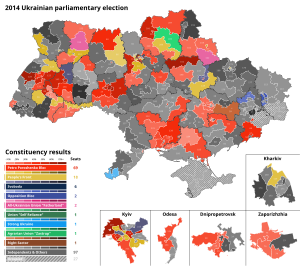
Back Парламенцкія выбары ва Украіне (2014) BE Выбары ў Вярхоўную Раду Ўкраіны (2014) BE-X-OLD Парламентарни избори в Украйна (2014) Bulgarian Eleccions al Parlament d'Ucraïna de 2014 Catalan Parlamentní volby na Ukrajině 2014 Czech Parlamentsvalget i Ukraine 2014 Danish Parlamentswahl in der Ukraine 2014 German Ουκρανικές βουλευτικές εκλογές 2014 Greek Elecciones parlamentarias de Ucrania de 2014 Spanish Ukrainan parlamenttivaalit 2014 Finnish
| |||||||||||||||||||||||||||||||||||||||||||||||||||||||||||||||||||||||||||||||||||||||||||||||||||||
423 of the 450 seats in the Verkhovna Rada[a] 226 seats needed for a majority | |||||||||||||||||||||||||||||||||||||||||||||||||||||||||||||||||||||||||||||||||||||||||||||||||||||
|---|---|---|---|---|---|---|---|---|---|---|---|---|---|---|---|---|---|---|---|---|---|---|---|---|---|---|---|---|---|---|---|---|---|---|---|---|---|---|---|---|---|---|---|---|---|---|---|---|---|---|---|---|---|---|---|---|---|---|---|---|---|---|---|---|---|---|---|---|---|---|---|---|---|---|---|---|---|---|---|---|---|---|---|---|---|---|---|---|---|---|---|---|---|---|---|---|---|---|---|---|---|
| Opinion polls | |||||||||||||||||||||||||||||||||||||||||||||||||||||||||||||||||||||||||||||||||||||||||||||||||||||
| Turnout | 51.91% ( | ||||||||||||||||||||||||||||||||||||||||||||||||||||||||||||||||||||||||||||||||||||||||||||||||||||
| |||||||||||||||||||||||||||||||||||||||||||||||||||||||||||||||||||||||||||||||||||||||||||||||||||||
| |||||||||||||||||||||||||||||||||||||||||||||||||||||||||||||||||||||||||||||||||||||||||||||||||||||
Snap parliamentary elections were held in Ukraine on 26 October 2014 to elect members of the Verkhovna Rada. President Petro Poroshenko had pressed for early parliamentary elections since his victory in the presidential elections in May.[3] The July breakup of the ruling coalition gave him the right to dissolve the parliament, so on 25 August 2014 he announced the early election.[4]
Voting did not take place in the Russian-occupied Autonomous Republic of Crimea and Sevastopol, nor in large parts of Donetsk and Luhansk oblasts because of the ongoing war in Donbas.[5] Because of this, 27 of the 450 seats remained unfilled.
The elections were seen as a realignment. Ruling from 2010 to 2014, and taking one of the top two spots in elections since 2006, the Party of Regions did not participate in the 2014 elections, while its informal successor Opposition Bloc received only 9% of the vote. For the first time since Ukrainian independence, the Communist Party of Ukraine failed to win a seat. Four newly created parties received the highest vote shares; the Petro Poroshenko Bloc (formed in July 2014 by Poroshenko's supporters), People's Front (split from Fatherland in August 2014), Self Reliance (registered in 2012) and Opposition Bloc (formed in September 2014 by a group of the former Party of Regions members).
The work of the new parliament started on 27 November 2014.[6] On the same day, five factions formed the "European Ukraine" coalition: Petro Poroshenko Bloc, People's Front, Self Reliance, Radical Party and Fatherland.[7] On 2 December the second Yatsenyuk government was approved.[8]
Cite error: There are <ref group=lower-alpha> tags or {{efn}} templates on this page, but the references will not show without a {{reflist|group=lower-alpha}} template or {{notelist}} template (see the help page).
- ^ https://www.dw.com/uk/виборчий-список-блоку-петра-порошенка-очолив-кличко/a-17921368 Виборчий список "Блоку Петра Порошенка" очолив Кличко
- ^ https://vybory.detector.media/2014/09/12/hanna-hopko-ocholyla-vyborchyj-spysok-partiji-samopomich-ehor-soboljev-13-j/ Ганна Гопко очолила виборчий список партії «Самопоміч», Єгор Соболєв – 13-й
- ^ Poroshenko hopes for early parliamentary elections in Ukraine this fall - presidential envoy, Interfax-Ukraine (19 June 2014)
- ^ Ukraine President Poroshenko Calls Snap General Election, Bloomberg News (25 August 2014)
- ^ Parliamentary elections not to be held at nine constituencies in Donetsk region and six constituencies in Luhansk region - CEC, Interfax-Ukraine (25 October 2014)
- ^ "Parliament to form leadership and coalition on November 27", UNIAN (26 November 2014)
- ^ "Five factions form Verkhovna Rada coalition".
- ^ "Rada supports coalition-proposed government lineup".







